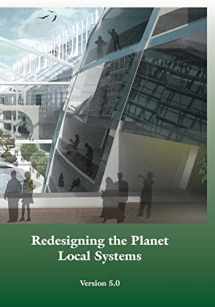
Redesigning the Planet: Local Systems: Reshaping the Constructs of Civilizations through the Use of Ecological Design & Other Conceptual & Practical ... Thought Experiments, & Eutopian Strategies
Book details
Summary
Description
This work is about sharing the local (as well as global) resources and services of the planet to meet the needs of all living beings and their community patterns. It uses ecological design to create a simple method to implement and manage the sharing. First, we assess what the local place needs to develop in a stable flow, then we set aside a satisfactory area of the place to ensure the continuing operation of evolution in wild systems. Next, we measure the ranges of productivities of wild ecosystems as well as agricultural and urban systems, then use those results to determine optimum human populations for local places, regions and the planet. Within human systems, every culture would claim a share of local resources and global services not set aside for wild regeneration.Ecological design would work on global and regional scales, as well as the local scale. For example, the Colorado river would be allocated a percentage of water to keep the river and its downstream ecosystems (including shallow ocean canyons) healthy-this may require 50% or more of all the water flow. The remaining water would be divided between resident cultures sharing the river environments upstream. This approach promises a fair way to deal with carbon emissions, toxic wastes, and energy use, also.The equal apportionment of 'resources' to all cooperating participants in the global commons (identified with the new word 'Koinomics'-See glossary for neologisms and terms) is supported by the theory and practice of recognizing and honoring the legacy of the entire planet that hosts its legatees as tenants (identified here as 'Legatism') and is supported by the 'rule' of all beings (identified as 'Panocracy'), although in the human legal system, humans represent the interests of all other beings, much as they are starting to do now. This reapportionment is enhanced by the wisdom of harmony (identified as 'Harmosophy') and the drawing and making of ecological zones (identified as 'Zonagraphy'), which emphasizes the relative separation of wild and artificial areas. This reapportionment of 'resources' that human communities have already claimed, as well as of resources that have been badly distributed as a result of theft or violence, may cause some degree of discomfort for wealthier groups, but that is minimal compared to the suffering and death under the current system, which encourages overconsumption and large differences in the distribution of wealth.Like metaphysics, ecological design has a vision that exceeds its bounds and a reach that exceeds its grasp. And, we have to use it to explore possibilities of local and global harmony, without having complete knowledge or experience. Ecological design requires participation and cooperation to accomplish its ambitious goals. It has to be flexible and adapt to changing environments.This means understanding challenges and problems, as well as natural and artificial ecosystems, histories and cycles, before using a variety of physical and conceptual tools to create ecological designs on local scales, but considering the regional and global implications. This means trying to design places, ecosystems and landscapes, as well as cycles and processes. It means redesigning flows of minerals and gases, wetlands and streams, domestic and wild forests, and animal paths and reserves. It means redesigning human patterns, from transportation corridors to traditional and modern cultures. It means redesigning agriculture, cities, buildings, neighborhoods, vehicles, industries, and medicine. It means trying to redesign social traps, cultural adaptations, corporate goals and responsibilities, formal commons, styles of conflict, economic frameworks, political forms and sizes, religious applications, and even advertising. And, the purpose of all this is to restore harmony to systems that encourage health and development.


We would LOVE it if you could help us and other readers by reviewing the book
Book review



